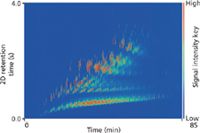A Short Introduction to Multidimensional GC
An excerpt from LCGC's e-learning tutorial on multidimensional GC at CHROMacademy.com.
Multidimensional gas chromatography (GC) is now an established technique for the analysis of complex samples in application areas such as petrochemistry, metabolomics, environmental and flavour and fragrance science.
The technique uses GC columns connected in series to achieve a complete separation of complex samples using orthogonal column chemistries. These separations are either impossible or very time consuming using a one-dimensional (1D) technique (that is, using only one GC column).

In theory, if each dimension is totally orthogonal, then the maximum peak capacity (Φ) can be calculated as the product of the individual peak capacities for each dimension:
In a situation where the first dimension has a peak capacity of 1000 and the second dimension has 30, the 2D GC×GC system would offer a peak capacity of 1000 × 30 = 30000. To achieve such peak capacity with a 1D separation, a 2-km GC column would be required (analysis time in the order of 1.5 years)!
Second-dimension columns must achieve separation much faster than their first-dimension counterparts to optimize the "sampling rate" from the first dimension and, therefore, they tend to be short. The length of the first column might typically be 20–30 m, the inner diameter 0.25 mm and the film thickness 0.25 µm. The second column is typically shorter (1–2 m), the inner diameter is narrower (0.1 mm) and the stationary phase is thinner (0.1 µm), to allow for faster separations. The reduction in internal diameter is used to counterbalance the decreases in efficiency (plate numbers) obtained from shorter columns. It is common to select a nonpolar column for the first-dimension separation and use a more highly polar phase in the second dimension.
The major instrument challenge in multidimensional GC is to achieve efficient "injection" of the effluent of the first dimension into the second. Columns joined in series are the simplest embodiments of multidimensional chromatography; however, the separations produced are limited by carrier-gas velocities because all the solutes transit both columns in a single continuous stream. When working with complex samples, peaks that are well separated by elution from the first column can come back together or might interfere with other peaks as they pass through the second column. Therefore, we need to "trap" or "bunch" discrete fractions from the first column before introduction into the second dimension. This is typically achieved using a "modulator" that is used to transfer effluent from the first-dimension column to the head of the second dimension column in short repetitive pulses. Modern instruments use two types of modulators: thermal (cryogenic or heated) and valve (time or pressure) modulators. Regardless of the design or principle, the rapid and efficient transfer of discrete fractions from one, many, or all peaks in the first dimension is absolutely critical to maintain the separation quality. There are as many subtle variations in the design and implementation of modulator devices as there are instrument manufacturers; however, there is no doubt that the modulator is the heart of the GC×GC system.
In "heart-cutting" systems, one or several discrete portions of a separation are directed from the first column to the second. Because only a few selected peaks enter the second column at a time, interference from other nearby peaks that precede or follow the heart cut is eliminated, and the second column's separation becomes largely independent from the first one.
In the much more complex technique of comprehensive multidimensional GC, all of the effluent from the first dimension column is sampled into the second. Correct sample modulation is essential in the comprehensive technique to successfully maintain resolution of all components in both the first and second dimensions. This technique generates huge amounts of data, and complex software is required to reduce the data to a usable form, typically represented via a 2D or 3D plot of the type shown in Figure 1. This 2D contour plot of a separation of light cycle oil uses colours to represent the signal intensity, the x-axis plots the separation in the first dimension (in minutes) and the second dimension separation is plotted on the y-axis (in seconds).

Figure 1: Data generated in a comprehensive multidimensional GC separation of light cycle oil.
Multidimensional GC data are primarily used for qualitative analysis. However, quantitative multidimensional analysis is possible.
While multidimensional GC brings many separation benefits, achieving efficient analyte transfer between columns and the complexity of data analysis are potential barriers to more wholesale adoption as a routine analytical technique.

Analysis of Pesticides in Foods Using GC–MS/MS: An Interview with José Fernando Huertas-Pérez
December 16th 2024In this LCGC International interview with José Fernando Huertas-Pérez who is a specialist in chemical contaminants analytics and mitigation at the Nestlé Institute for Food Safety and Analytical Sciences at Nestlé Research in Switzerland, In this interview we discuss his recent research work published in Food Chemistry on the subject of a method for quantifying multi-residue pesticides in food matrices using gas chromatography–tandem mass spectrometry (GC–MS/MS) (1).
The Use of SPME and GC×GC in Food Analysis: An Interview with Giorgia Purcaro
December 16th 2024LCGC International sat down with Giorgia Purcaro of the University of Liege to discuss the impact that solid-phase microextraction (SPME) and comprehensive multidimensional gas chromatography (GC×GC) is having on food analysis.












